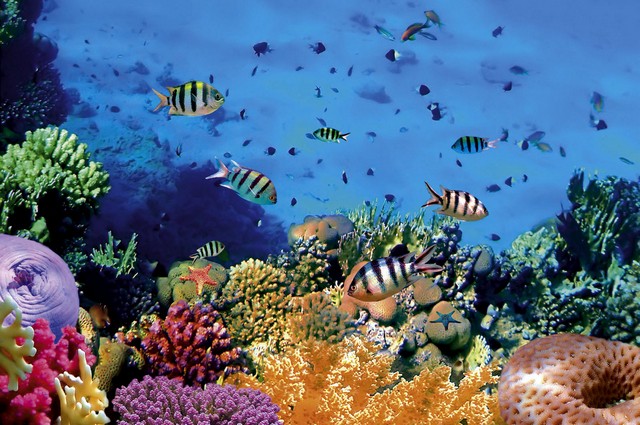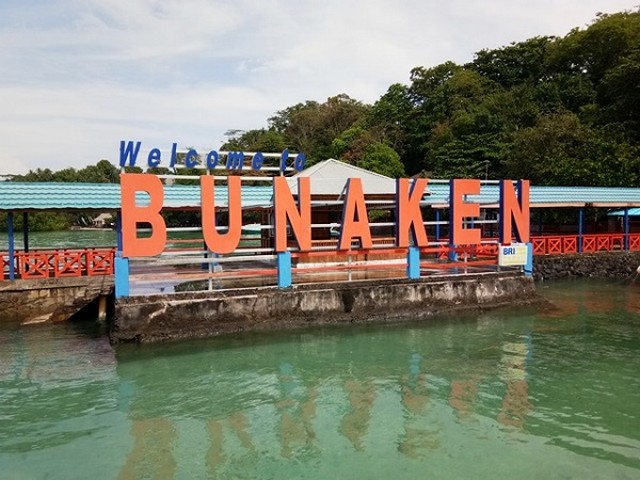Bunaken, a National Park in the Center of the World's Coral Triangle
Indonesia is a great place for diving activities. Just count, in this archipelago country located between two continents and oceans there are more than 17,000 islands from the tip of Sumatra to the land of Papua. It is surrounded by borders between the Andaman Sea, Singapore, the South China Sea, Malaysia, and the Philippines, as well as the Pacific Oceans of Papua Niugini, the Indian Ocean, and Australia. One of the interesting places for diving is Bunaken, a national park in the center of the world's coral triangle.
 |
| The beauty and uniqueness of Bunaken Marine Park (Photo: limakaki.com) |
Bunaken is one of the exotic diving sites in Indonesia that is so many and diverse. Starting from Seribu Island, Ujung Kulon, Karimun Jawa, Kalimantan, Bali and Sumbawa, Komodo, Wakatobi, Bangka, Banda, and Flores, Bintan, Makassar, to Raja Ampat in Irian Jaya.
Location of Bunaken National Park
Bunaken National Park is a tropical aquatic ecosystem conservation area located in the center of the world's coral triangle and has an area of 89,065 hectares. Of this area, as much as 97 percent of them are marine habitats, while the remaining 3 percent is land.
The location of Bunaken National Park area is in North Sulawesi Province with Manado City as the closest city.
 |
| Bunaken Pier (Photo: indonesiatraveler.id) |
Bunaken National Park includes five islands, namely Bunaken Island, Manado Tua Island, Mantehage Island, Naen Island, and Siladen Island.
The Beauty of Bunaken as a Diving Spot
Bunaken Island, located in North Sulawesi, can be reached by direct airplane from Jakarta for 3 hours and 10 minutes. For about 15-40 minutes from the outskirts of Manado, the capital of North Sulawesi Province by motor boat, passing through Mount Manado Tua, you can see directly Bunaken Island which is right next to Siladen Island. Bunaken Island has a world-renowned national marine park with an area of more than 75,000 hectares, which is divided by 3 percent of land and 97 percent of the ocean, including Bunaken Marine Park.
Also read: Exciting traveling at Bahak Indah Tongas Beach, Probolinggo.
One of the travel magazines in the UK in an article entitled "World Top 10 Best Dives Destination" named Bunaken Marine Park as one of the best diving destinations in the world. The award is not excessive because Bunaken Marine Park which was inaugurated in 1991 is surrounded by five islands in it, namely Manado Tua Island, Bunaken Island, Siladen Island, Mantehage Island, along with several islands, and Naen Island which in total has 29 fantastic dive spots!
 |
| Snorkeling in Bunaken (Photo: daftartour.co.id) |
Bunaken Island is one of the islands that has the most marine biodiversity in the world. Bunaken Marine Park itself is a protected marine park because some various plants and animals are protected for fisheries and marine purposes and of course tourism.
 |
| Enjoy the beauty in Bunaken (Photo: mongotrip.com) |
There are no off-seasons, meaning you can dive in Bunaken at any time. According to the experience of some divers, the best time to dive in Bunaken is in May and June. At such times you will be greeted by clear and warm sea water (air temperature 26 degrees celsius-31 degrees Celsius). The calm sea water is almost without waves and currents, with a visibility of 20 meters-35 meters, allowing you to see the charm of coral reefs and colorful fish with a depth of only 5 meters! The diving depth in Bunaken is between 5 meters and 40 meters.
History of Bunaken National Park
Quoting from Kompas.com, the establishment of Bunaken National Park is based on the Decree of the Minister of Forestry Number 730 / Kpts-II / 1991 signed on October 15, 1991.
While the inauguration of Bunaken National Park was carried out by President Suharto on December 24, 1992, in Bongohulawa.
The main functions of Bunaken National Park include protecting life support systems, and preservation of plant and animal diversity.
In addition, it also functions as a sustainable use of biological natural resources and ecosystems.
Also read: The beauty of biodiversity in Wasur National Park, Merauke, Papua.
Although it was only established in 1991, the name Bunaken itself has been known since 1885. At that time, the people of Tanjung Parigi chose to move to the southeast, precisely on the beach facing Manado City.
The new place is called Wunakeng by the community, which comes from the word Kiwunakeng which means residence.
Over time, this area is also called Bunaken which comes from the word Pamunakeng which means a stopover place for ships. While marine biodiversity in Bunaken National Park was only known in 1975 by a group of divers.
Flora and Fauna of Bunaken National Park
Bunaken National Park is in the center of the Coral Triangle which stretches in the waters of Indonesia, Malaysia, to Timor Leste.
Thus, Bunaken National Park has a very rich coral reef ecosystem. Based on existing data, there are 390 species of coral reefs in this national park area.
The area of coral reefs in this region reaches 11,709 hectares, with 68 ganera.
 |
| Turtles (Photo: 4.bp.blogspot.com) |
There are fifty-eight types of coral reefs and 2,000 species of fish in Bunaken Marine Park. Among them are Gusumi Horse fish (Hippocampus), White Oci (Seriola rivoliana), Yellow-tailed Lolosi (Lutjanus kasmira), grouper (Epinephelus spilotoceps and Pseudanthias hypselosoma), Ila Gasi (Scolopsis bilineatus), mollusks such as giant clam (Tridacna gigas), Goat Head (Cassis cornuta), hollow Nautilus (Nautilus pompillius), and many more. In addition, many rare marine animals can be found in Bunaken, such as coelacanths, dugongs, whales, dolphins, and turtles.
Bunaken National Park also has several types of mangrove forests covering an area of 2,434 hectares with 28 species.
There is also a seagrass meadow covering an area of 5,108 hectares with 9 species, as well as more than 2,000 species of reef fish, 200 species of mollusks, and 8 species of marine mammals. On the mainland of Bunaken National Park, there are sago, woka, silar, and coconut trees. In addition, there are also several species of land animals such as deer and cuscus. While in the mangrove forest, there is a habitat for crabs, mollusks, and seabirds.
Route to Bunaken National Park
In the Bunaken National Park area there are about 22 villages inhabited by at least 35,000 people.
This Bunaken National Park area is perfect for diving and snorkeling lovers. However, Bunaken National Park remains a paradise for marine tourism connoisseurs, especially underwater tourists.
To get to Bunaken National Park, the route is as follows:
- Visitors must cross through Manado Port in Molas District.
- From Manado Port, visitors are directed to take a motorboat to the selected island in Bunaken National Park. Travel time to each island is different.
- To go to Siladen Island it takes 20 minutes, Bunaken Island 30 minutes, Montehage Island 50 minutes, and Nain Island 60 minutes.
- On Bunaken Island itself there is a beach that is a favorite of visitors, namely Liang Beach.
Liang Beach is the center of the community's economic movement with many selling food, drinks, souvenirs, to diving equipment rental. Visitors at Liang Bunaken Beach also have the iconic Bunaken monument.
To enter Bunaken National Park, a ticket of IDR 5000 is charged for local visitors and IDR 150,000 for foreign tourists.
That's a little information about "Bunaken, a national park at the center of the world's coral triangle". May it inspire and fascinate those of you who want to dive and enjoy something different.

0 Response to "Bunaken, a National Park in the Center of the World's Coral Triangle"
Post a Comment